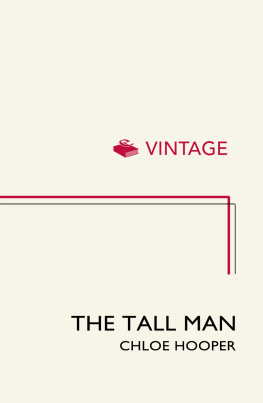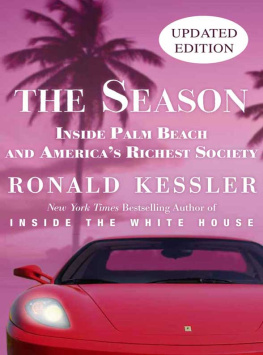ALSO BY CHLOE HOOPER
A Childs Book of True Crime
About the Author
Chloe Hooper was born in 1973. Her highly praised first novel, A Childs Book of True Crime (2002), was shortlisted for the Orange Prize. Her Observer article about the Doomadgee case, Island of Lost Souls, was shortlisted for the Amnesty International Media Awards. She is also the author of The Engagement and The Tall Man, which won seven major literary awards in Australia.
About the Book
When Cameron Doomadgee, a 36-year-old member of the Aboriginal community of Palm Island, was arrested for swearing at a white police officer, he was dead within forty-five minutes of being locked up. The police claimed hed tripped on a step, but the pathologist likened his injuries to those received in a plane crash. The main suspect was the handsome, charismatic Senior Sergeant Christopher Hurley, an experienced cop with decorations for his work.
In following Hurleys trail to some of the wildest and most remote parts of Australia, Chloe Hooper explores Aboriginal myths and history and uncovers buried secrets of white mischief. Atmospheric, gritty and original, The Tall Man takes readers to the heart of a struggle for power, revenge and justice.
This ebook is copyright material and must not be copied, reproduced, transferred, distributed, leased, licensed or publicly performed or used in any way except as specifically permitted in writing by the publishers, as allowed under the terms and conditions under which it was purchased or as strictly permitted by applicable copyright law. Any unauthorised distribution or use of this text may be a direct infringement of the authors and publishers rights and those responsible may be liable in law accordingly.
Version 1.0
Epub ISBN 9781407021065
www.randomhouse.co.uk
Published by Jonathan Cape 2009
2 4 6 8 10 9 7 5 3 1
Copyright Chloe Hooper 2009
Chloe Hooper has asserted her right under the Copyright, Designs and Patents Act 1988 to be identified as the author of this work
This book is sold subject to the condition that it shall not, by way of trade or otherwise, be lent, resold, hired out, or otherwise circulated without the publishers prior consent in any form of binding or cover other than that in which it is published and without a similar condition, including this condition, being imposed on the subsequent purchaser
First published in Great Britain in 2009 by
Jonathan Cape
Random House, 20 Vauxhall Bridge Road,
London SW1V 2SA
www.rbooks.co.uk
Addresses for companies within The Random House Group Limited can be found at: www.randomhouse.co.uk/offices.htm
The Random House Group Limited Reg. No. 954009
A CIP catalogue record for this book is available from the British Library
ISBN 9780224084666
For Justin and Nicholas
Contents
ON AUSTRALIAS REMOTE Cape York Peninsula there are spirits with long, thin arms and long, thin legs that move unseen in the night to do evil. By day they slide back into the countrys sandstone cliffs, living in the cracks. On rock faces, in gullies and gorges and caves, their stretched-out bodies are painted in red ochre with allseeing white eyes.
To find them I flew and drove to the tiny town of Laura, in Far North Queensland, and followed a guide along narrow walking tracks thousands of years old, up a steep escarpment.At the top, the guide yelled out a greeting to the spirits. Otherwise, he said, they would come and cut out our kidney fat.
It had been years since anyone had visited this place. Recent rains had left the saplings vivid green, and the ferns that grew from rocks made hanging gardens. This was a wet-season camp, a network of boulders and caves whose walls and ceilings were covered in layers of paintings maybe fifteen thousand years old: kangaroos, crocodiles, emus, dingoes, yams and their twisting roots, weapons, beehives with swarms of bees, stars; all the things of the cosmos drawn so they might multiply and release the bounty of the land.
Along one cliff wall, the orange and brown hues of the sandstone morphed into more recent figures: paintings of two white men lying down. They wore red half-moon caps and blue shirts, and were naked below their waists, their skin a pale, creamy ochre. Both men had rifles. They were police. This site was used for sorcery, purri purri.
On a cave wall a kilometre or so away, the guide had shown me a scene painted in the late nineteenth century of a European wearing jodhpurs and boots. He was midair, vainly holding to the reins as he was thrown from his horse. A rifle flew from his hands. A naked woman lay on the ground. Perhaps the man had stolen her; it was common on the frontier. Whoever painted this wanted to kill the European, to doom him, as the self-taught ethnographer W. E. Roth termed it a century ago. A man could be doomed to be struck by lightning or crushed by a falling tree, though it would not be the lightning or the tree that killed him, but the curse. The Aborigines called it singing him.
Sorcery paintings became more prolific while northern Australia was being colonised. In 1872nearly a hundred years after Captain Cook claimed the continent for Great Britaingold was discovered in a valley near Laura. When local Aborigines speared the Europeans stock or pilfered their supplies, white settlers and then trooperswhite and blackset out from the town in dispersal parties. The Aborigines tried to use purri purri against the whites rifles, magic objects that could produce thunder and lightning. They tried to sing the guns and to sing the guns fruit or kernelsthe bulletsso they wouldnt fire straight. But the place-names marking Cape Yorks red dirt roads tell the story: Spear Creek, Rifle Creek, Double Barrel Creek, Revolver Creek. A photograph of the Laura Native Mounted Police from around 1880 shows five Aboriginal troopers in their uniforms with peaked caps and rifles, flanking their tall white commander. Some traditional Aborigines lived like fugitives in these hills until the 1920s, but influenza and armed troopers kept coming their way.
I stared at the blue-shirted men on the cave wall and thought that the motivation to paint them must have been strong. Blue pigment is very rare: someone had gone to great trouble to find and mix these paints. The smaller of the figures had two blue dots for eyes, the larger one brown-dot eyes and a cross that counted for a nose and mouth.
The second man was two metres tall and horizontal. Under his shirt he was reptilian. His skin had been crosshatched like a crocodilesevery part of it, including his penis. Below him a great serpent, painted in red ochre, reached four metres along the cliff face. The snakes tongue was striking the sole of the mans bare foot. This snake was the instrument of doom. Inside its body were stencilled handprints, like signatories to an execution. I curse your foot, I curse your leg, I curse your heart, your shoulder, your neck, the guide said quietly. This was not a generic trooper. The people who painted him knew him. They knew his height. They knew the colour of his eyes.
On the slow walk back down, nothing stirred in the bush. I asked the guide if he knew Chris Hurley, a white policeman who had once worked in the near deserted town of Laura down below. Hurley was popular in the Aboriginal communities and frontier towns where he chose to serve. Hed been decorated for his bravery. And he was tall, I said, two metres tall like the figure on the cave wall.
For two years I had been following his story: one morning, two hundred miles away on Palm Island, hed arrested an Aboriginal man for swearing at him. Forty minutes later, the man, Cameron Doomadgee, was dead on a cell floor with injuries usually seen in fatal car accidents. Hurley claimed his prisoner had tripped on a step.














